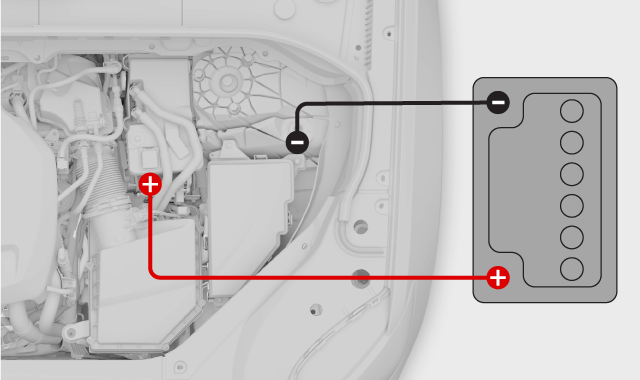Warning
- If the 12 V battery has been disconnected, window pinch protection will need to be reset.
- The battery can generate oxyhydrogen gas, which is highly explosive.
- The battery contains sulfuric acid, which can cause serious burns and corrosion. If the sulfuric acid comes into contact with skin or clothes, rinse them with plenty of water. If the acid gets into eyes, seek medical attention immediately.
- Never smoke near the battery.
Do not use 48 V components
- Do not touch components which are not clearly described in the user manual. Components with 48 V can be dangerous if handled incorrectly.
- Never use the 48 V battery to jump-start another vehicle.
- Never connect any external equipment to the 48 V battery.
Important
Do not charge another vehicle
The charging points on your vehicle's 12 V battery are only meant for charging your own vehicle. Do not attempt to charge another vehicle.

2
1
3
4
- 1External battery's positive terminal.
- 2Positive terminal on your vehicle's 12 V battery.
- 3External battery's negative terminal.
- 4Negative terminal on your vehicle's 12 V battery.
There are some tasks you need to do before jump starting your vehicle.
- You need access to an external charger or 12 V battery, such as in another vehicle, and a pair of jumper cables.
- Make sure your vehicle is turned off.
- If using another vehicle's 12 V battery, make sure its engine is off and that the vehicles are not in contact with each other.
Connecting the cables
Attach the red jumper cable clamp to the external battery's positive terminal.
Warning
Make sure that the jumper cables only come into contact with the charging terminals in the engine compartment. Carefully avoid allowing the jumper cables to contact other components.
Remove the cover for the positive terminal on your vehicle's 12 V battery and attach the other end of the red lead to the terminal.
Attach the black cable clamp to the external battery's negative terminal.
Attach the other end of the black lead to the negative terminal on your vehicle's 12 V battery.
Check that the clamps are properly attached. Poor contact can cause sparks or loosening of the clamps during the start attempt.
Start attempt
Activate the external battery and charge your vehicle's battery for a few minutes. If you are using the battery on another vehicle, let its engine run at a slightly higher idling speed than normal, approx. 1500 rpm.
Warning
Do not touch the cables or clamps while either battery is active. There is a risk of creating sparks.
Start your vehicle.
If the start attempt fails, keep charging for 10 minutes and then try again.
While your vehicle is still running, remove the leads in the opposite order to how you installed them. First remove the black lead from your 12 V battery and then the black lead from the external battery. Next, remove the red lead from your 12 V battery and then the red lead from the external battery. Make sure that the black cable does not touch any of the positive terminals or the red cable.
Keep your vehicle running for a while to charge the 12 V battery. It charges better while you drive.
Note
Make sure the start and stop feature is disabled until the battery has had enough time to recharge. Otherwise, there is a risk that the auto-start will fail.